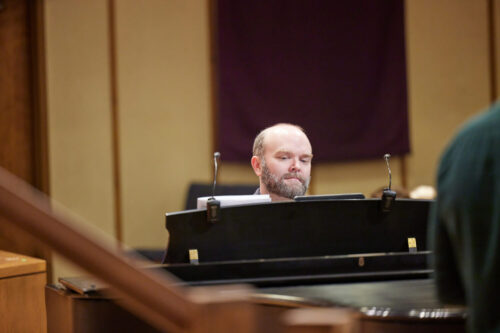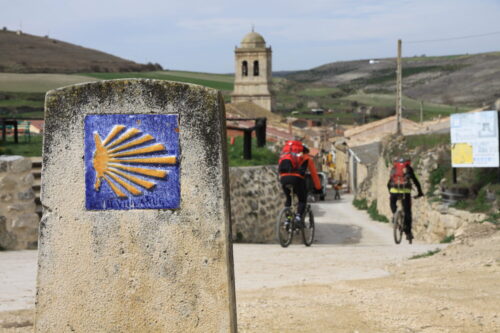Covenant member Alyson Wagnor attended a Covenant Lab. She wrote the following article, reflecting on the class and her background.?
 At the introductory session of Jon Wasson?s Covenant Lab, Creating the Beloved Community: A Christian Response to Racism, Jon asked each of us to think about our first experience with race. Long after class was dismissed, I pondered the question. Race has been part of my entire life. Yet until recently, the uncomfortable word occupied my perceptions of self and others like the negative space in a drawing; it was always in the background, but for a long time I didn?t address it.
At the introductory session of Jon Wasson?s Covenant Lab, Creating the Beloved Community: A Christian Response to Racism, Jon asked each of us to think about our first experience with race. Long after class was dismissed, I pondered the question. Race has been part of my entire life. Yet until recently, the uncomfortable word occupied my perceptions of self and others like the negative space in a drawing; it was always in the background, but for a long time I didn?t address it.
What Am I?
My mother is a first-generation Japanese who moved from Japan to the United States after marrying my father, a white American of German/Czech descent. Although I spent most of my childhood in Austin, my family lived in Tokyo for a couple of years when I was in elementary school. White and Asian peers alike singled me out for being different from them. I experienced feelings of alienation from both sides of my ancestry.
For me, the ubiquitous ?What is your race/ethnicity?? question on Scantron exams and questionnaires in school felt like a test I could never pass. My answers vacillated between ?Caucasian? and ?Asian/Pacific Islander,? and often I worried that I?d chosen the wrong answer. I felt like I wasn?t white enough or Asian enough. This is one reason the word ?race? made me uncomfortable: if people were supposed to belong to different races, did that mean I had to divide myself up as if I were a parcel of land with ill-defined borders? It was easier not to think about it.
I also didn?t like to think of different races because in my mind, all people were part of one human race. This idealistic view was largely shaped by my experience living in Tokyo, where my family mingled with people from around the world at school and church, and in our neighborhood. In this highly concentrated environment of international expatriates, I saw an example of what humanity could be like?many nationalities living, studying and worshiping together in peace.
I See Color
Finally, a couple of years ago, I experienced a rude awakening. I was listening to a podcast. An Asian-American woman commented in response to the ?I don?t see color? argument that for her, it?s not a choice: she sees color every day when she looks in the mirror. All of a sudden, I felt angry and wasn?t sure why. After some pondering, I realized I was angry about this dismissive platitude that is painless for whites to say. I was angry and ashamed that I had passively accepted this message without questioning it. Most of all, I was angry that I?d never had the self-awareness to identify as a person of color. In failing to embrace the full complexity of my own racial heritage, I had failed to seek understanding of other racial identities and experiences, particularly those who have suffered the far-reaching effects of institutional racism.
Attempting to correct this gap in my understanding of race, I began to explore perspectives by people of color. I read books, followed influencers on social media and listened to podcasts. With newfound awareness, I wondered: How can I even begin to make a difference in the fight against racism?
What Racism Is?and Is Not
In the Covenant Lab, I learned that the first step is to understand what race and racism are and?just as important?what they are not. The literature Jon shared with us clarified that race is a social construct based on the concept of whiteness and white supremacy. It is not a genetic trait; it has no biological basis. Racism is a man-made system that institutionalizes privilege for people who are labeled ?white? and institutionalizes disadvantage for people labeled ?non-white.? It is not individual prejudice or bigotry, although those mindsets are certainly contributing factors. Racism began with the Western colonialism of indigenous peoples throughout the world and persists in the United States, which was founded on the idea that ?all men are created equal? and yet has dealt an egregiously unequal hand to people of color, who helped build a prosperous nation largely for the benefit of whites.
Domination and Love Cannot Coexist in God?s Creation
Once those of us who identify as white come to understand the full impact of racism, the next step in fighting it is to acknowledge that if we have experienced the benefits of white privilege?and that is nearly all of us to some degree?then we are part of the problem.
This systemic racism should be particularly disturbing to Christians, because it absolutely runs in opposition to God?s vision of humanity: ?So God created human beings in his own image. In the image of God He created them; male and female He created them? (Genesis 1:27 NLT). Furthermore, Jesus demonstrated what love for our neighbors ought to look like by telling a parable in which a Jew, attacked by bandits and left for dead, receives help not from Jewish clergy who pass by without stopping, but from a Samaritan. Jews despised Samaritans for their ?impure? mixed heritage, resulting from the intermarrying of Assyrians with Jews. Jesus couldn?t have made his point any more effectively: love for one?s neighbors includes people of all ethnicities.
The dissonance between racism and the gospel of Christ is clear. If we are to love others as God first loved us, domination of any kind must be eradicated. African-American feminist and cultural critic bell hooks in her book, All About Love, expresses in no uncertain terms that ?Domination cannot exist in any social situation where a love ethic prevails.?
Begin Where You Are
I know God?s work in this world is not finished until every race, nation and people group has the opportunity to know freedom in Christ. The task seems even more daunting now that I have greater awareness of how much racism has defaced the humanity God created in His own image. So where do I go from here?
Jon advised that we begin where we are. First, we must confess our silent participation in institutional racism, and then we must intentionally seek reconciliation in our community with the vulnerability that accompanies an often uncomfortable subject.
Now I understand I don?t have to strive to become white enough or Asian enough; I am white and I am Asian exactly as God intended to create me and I bear His image just like the rest of humankind. I do need to confess I have spent too much of my life being ignorant of the race issues that affect other people of color to a far greater extent than me. I have never experienced the color of my skin as a threat to my personal safety or as a barrier to my social, educational and economic advancement. It?s humiliating to realize the breadth and depth of my ignorance. But you have to start somewhere and humility is a good place to begin.
Suggested Further Reading
James Baldwin, ?A Letter to My Nephew,? The Progressive. December 1962. http://www.progressive.org/print/5047/letter-my-nephew.
Ta-Nehisi Coates, Between the World and Me. New York: Spiegel & Grau, 2015.
James H. Cone, ?Theology?s Great Sin: Silence in the Face of White Supremacy,? Soul Work: Anti-Racist Theologies in Dialogue, eds. Marjorie Bowers-Wheatley and Nancy Palmer Jones, 1?15. Boston: Skinner House Books, 2003.
-written and graphics by Alyson Wagnor




